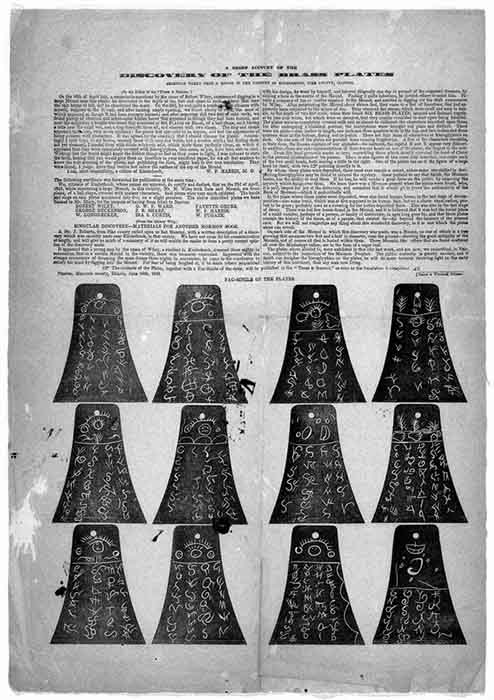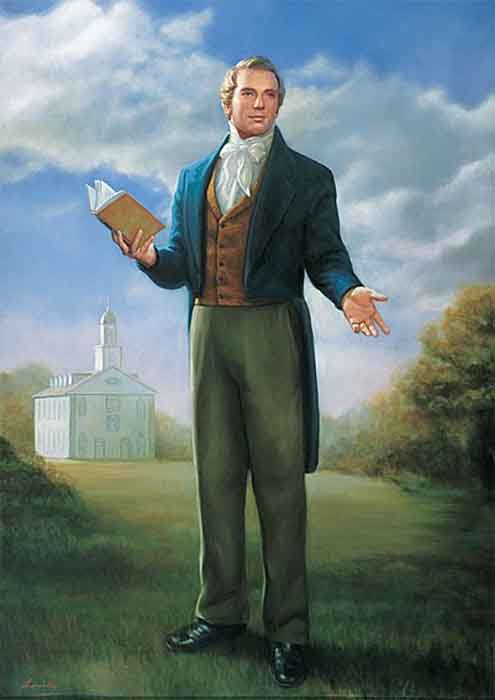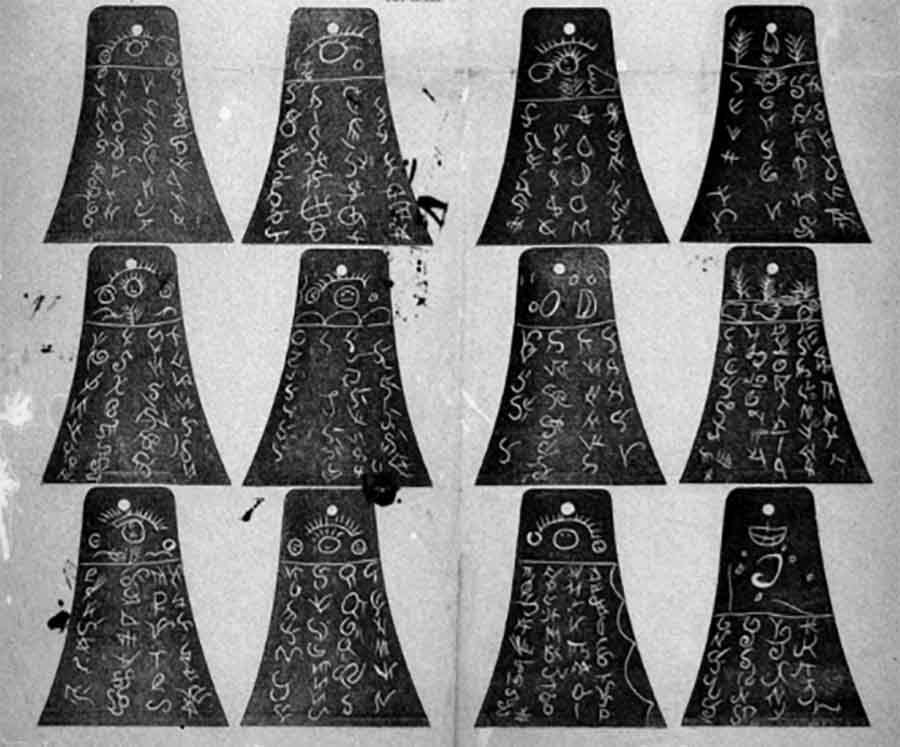Latter Day Forgeries: The Hoax of the Kinderhook Plates
In the 19th century, golden plates were discovered in Kinderhook in the United States. They were meant to reveal an ancient pharaoh’s lineage, but all was not as it seemed.
The first week in May 1843 brought a discovery that would mark the town of Kinderhook out for historical scandal. Kinderhook lies 75 miles (120 km) south of Nauvoo in Pike County, in the state of Illinois, and it was there that a respectable merchant, Robert Wiley, began to dig into a large mound around the 16th of April.
Although he was forced to stop when it started to rain, he later returned with more men to recommence digging again on the 23rd of April. After hours of work, they were greeted with burned rock and human bones in and amongst which there were six bell-shaped tablets, made of brass and covered with hieroglyphics none of which the digging party was able to read. Unsurprisingly, this generated great interest in the locale and the papers.
How Were They Found And What Did They Mean?
Robert Wiley had shown no interest in archaeology before this, and yet had been driven to not only begin digging a local mound but encourage people from the local community to join him. Once they had found the plates, a member of the digging party, W.P. Harris, took them home to wash them.
He found them difficult to clean and so used a sulfuric acid solution to remove much of the debris. It was during this process that the hieroglyphics were discovered.

Local announcement regarding the plates (Unknown Author / Public Domain)
The plates were briefly displayed in Kinderhook but soon attracted the attention of the founder of the Latter-Day Saint movement, also known as the Mormons. In 1823, Joseph Smith claimed to have uncovered similar golden plates and translated them into what became known as the “Book of Mormon”.
He is said to have accomplished this using divine inspiration from God, as well as tools and his “seer stone”, described as smooth, brown, and egg-sized. For this reason, the plates were sent to Nauvoo, where Smith was building a boarding house.
Joseph Smith’s Translation
Joseph Smith’s secretary, William Clayton, recorded in his diary that when Smith had the plates in his possession, he asked for his Hebrew Bible and his lexicon. This was to help him translate the plates by using more traditional means rather than using his brown seer stone or relying on God.
- The Disc of Sabu: Ancient Egyptian Water Pump or Alien Hyperdrive?
- Out of Place Chinese Coins Prompt Wonder: Did Medieval Asia and Britain Interact?
Clayton also wrote in his journal that he had seen the six plates covered in ancient letters. Smith eventually claimed that he was able to translate a portion, and that it stated the bones that had been found were those of a descendant of Ham, one of the sons of Noah, through the line of the Pharaohs, kings of Egypt.
It should be noted that the translation by Joseph Smith took him many years. It also cost him significant amounts of money, as he purchased and chased down papyrus documents and ancient scrolls to aid him in his translation.

Joseph Smith, Prophet of the Latter Day Saints (Unknown Author / CC BY-SA 4.0)
Up until 1980, the Latter-Day Saint’s church claimed that these plates were authentic. They also stated that the information Smith was able to get from the plates proved his abilities to translate these items, and that this was further confirmation that he was a true prophet of the Mormons.
The Hoax
But then something happened. In 1981 the Kinderhook Plates were subjected to tests to assess their authenticity. Professor D. Lynn Johnson of the Department of Materials Science and Engineering at North Western University examined the plate using microscopy and various scanning devices. Electronic and chemical analysis of one of the plates indicated that the plate was a fake, and that it was made no earlier than the 19th century.
What he found was that the composition of the metal and its tolerances were consistent with a 19th-century blacksmith shop. Even more so he found traces of nitrogen in nitric-etched grooves on the surface, showing that it could not have been an ancient tablet.
Looking back at earlier sources shows that this was not the first time the plates had come under scrutiny. Wilbur Fugate, a local Kinderhook man, confessed in a letter in 1879 to being behind the hoax. He wrote “Wiley and I made the hieroglyphics by making impressions on beeswax and filling them with acid. When they were finished, we put them together with rust made of nitric acid, old iron, and lead.” Wiley then said he planted the plates at the bottom of a hole he had dug in a mound nearby, before fetching other men to help him.
Professor Johnson also confirmed that the plate they were testing was one of the original plates handed to Joseph Smith to examine and translate, and not some later copy. He had noticed that one of the features on the plate was small dents in the surface, interpreted during translation as stroke in one of the characters.
- Experts Finally Decode 2000-year-old ‘Mirror Writing’ Papyrus
- 17 Out-of-Place Artifacts Said to Suggest High-Tech Prehistoric Civilizations Existed
If the plate was a copy of an earlier original, then these marks would have been etched rather than dented. This confirmed that these were the original plates, and therefore that it was the original plates that were forgeries.
The Mormons Respond
This has, unsurprisingly, caused consternation in the Church of the Latter-Day Saints. They had spent 140 years defending Joseph Smith, and claiming his ability to translate these plates proved he was a prophet. However, science proved that this was not the case.

The Mormons were swift to distance themselves from the forgeries (Pixabay / Public Domain)
To avoid embarrassment, the church needed a sacrificial lamb, and turned on William Clayton, the scribe of Joseph Smith. They agreed that the story of Joseph Smith’s translation was not true, but that this story actually came from the journal of William Clayton rather than Smith himself. Therefore it was Clayton who was the liar, not Smith.
This was not a strong defense. Next, the Church turned to attacking the perpetrators of the hoax, casting Smith as a victim of a cruel prank. They claimed Smith had never made the translation and there is no evidence to suggest that he had done so.
Embarrassing as this about-turn was for the Church, it was a necessary rebuttal as it would otherwise put into doubt the legitimacy of the Mormon church. If Joseph Smith were caught in this hoax it would cast into doubt all other claims he made, striking at the core of Mormonism. After all, he had translated the central Book of Mormon that the church followed from similarly described golden plates.
So Where do We Stand?
It looks a lot like Smith was caught pretending to understand hieroglyphs which turned out to be gibberish, and there is no escaping that this looks bad for Mormons. But the fact is, we just don’t know what happened, and the true event surrounding the Kinderhook Plates will always be a mystery.
The little translation we have comes from Joseph Smith, who may or may not have ever started translating them, and who may or may not have interpreted them incorrectly. All that we can be sure of is that the plates were a 19th century forgery. Whether Smith ever believed they were real, or whether he claimed to be able to translate them can never be known.
Top Image: Detail of the Kinderhook Plates. Source: Public Domain
By Kurt Readman
References
A brief account of the discovery of the brass plates recently taken from a mound in the vicinity of Kinderhook, Pike County, Illinois ... Nauvoo, Hancock county, Illinois, June 24th, 1845. Available at: https://www.loc.gov/item/rbpe.01702500/
Atterbury, J. 2018. How the Kinderhook Plates disprove Mormonism. Available at: https://jamesattebury.wordpress.com/2018/08/05/how-the-kinderhook-plates-disprove-mormonism/
Gale, N. 2019. History of the Kinderhook Plates. Available at: https://drloihjournal.blogspot.com/2019/06/history-of-the-kinderhook-plates.html
Hauglid, B. M. 2011. Did Joseph Smith Translate the Kinderhook Plates? Available at: https://rsc.byu.edu/no-weapon-shall-prosper/did-joseph-smith-translate-kinderhook-plates
Kimball, S. B. 1981. Kinderhook Plates Brought to Joseph Smith Appear to Be a Nineteenth-Century Hoax. Available at: https://www.churchofjesuschrist.org/study/ensign/1981/08/kinderhook-plates-brought-to-joseph-smith-appear-to-be-a-nineteenth-century-hoax?lang=eng
LDS discussions. 2021. Overview of the Kinderhook Plates. Available at: https://www.ldsdiscussions.com/kinderhook-plates
Massie, M.D. 1906. Past and Present of Pike County, Illinois. Available at: https://archive.org/details/pastpresentofpik00mass/page/86/mode/2up
Mormon Think. 2021. Kinderhook Plates. Available at: http://www.mormonthink.com/kinderhookweb.htm
Peterson, M.E. 1979. Those gold plates! Available at: https://archive.org/details/thosegoldplates00pete/page/n11/mode/2up
Roundy, J. 2020. Kinderhook Plates Hoax- Much ado about Nothing!. Available at: https://latterdaysaintsqa.com/kinderhook-plates-hoax-much-ado-about-nothing/
Runnells, J. 2013. Kinderhook plates & Translator Claims. Available at: https://cesletter.org/debunking-fairmormon/kinderhook-plates.html#summary
The Church of Jesus Christ of Latter-day Saints.1962. The Improvement Era. Available at: https://archive.org/details/improvementera6509unse/page/n24/mode/2up?view=theater
The Museum of Hoaxes. 2021. The Kinderhook Plates. Available at: http://hoaxes.org/archive/permalink/kinderhook_plates




















Comments
First I’ve heard of those. Must have been pretty embarassing. That has apparently not deterred the Mormons belief.